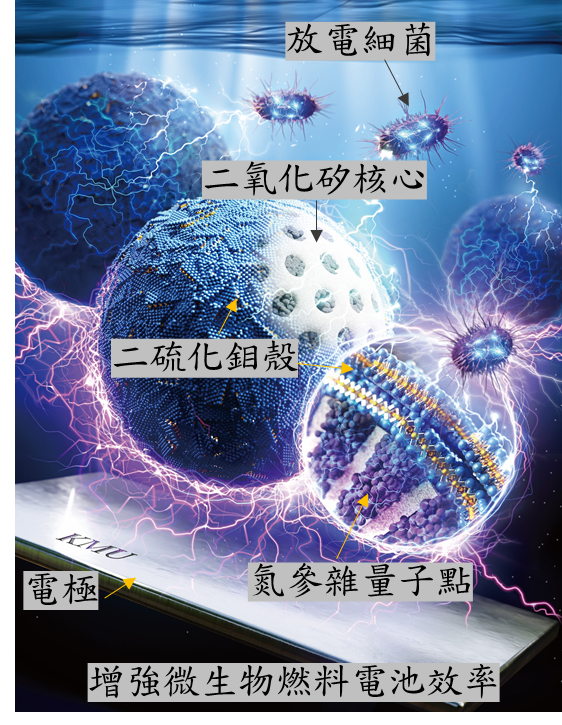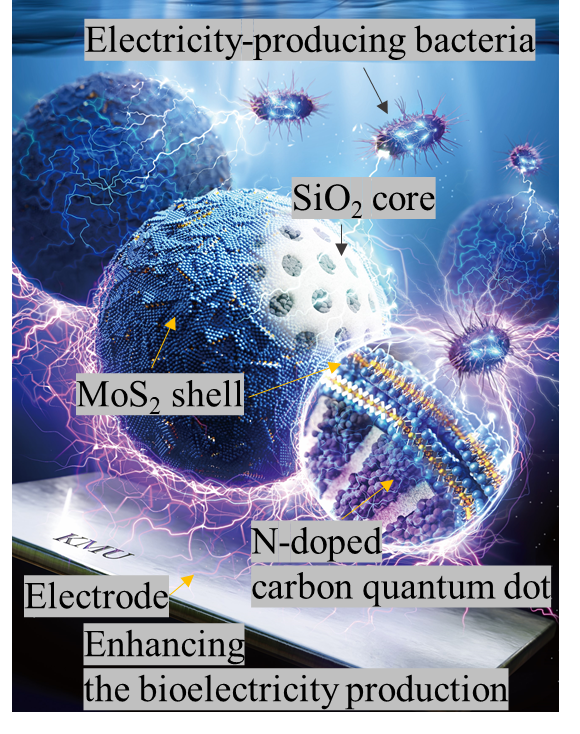奈米級電容協助放電細菌的電力輸送以增強生物電池效率
奈米級電容協助放電細菌的電力輸送以增強生物電池效率
放電細菌就像電鰻一樣,在特定條件下對環境釋放電子,而這邊的特定條件即是提供細菌所需的電子供體(食物),在經過細菌內的呼吸作用後將代謝電子釋出,達到放電的結果。當中,代謝電子從細胞內轉移至環境中仍需要導電性蛋白質的幫助,而這類蛋白也富含於放電細菌之中。這類細菌在環境礦物質平衡上扮演舉足輕重的角色,近年也逐漸衍伸出微生物電池的應用,這類電池有望在未來用作長戴型生物裝置與奈米機器人的電池,但在此之前,其微生物燃料電池之發電效率仍有待進一步提升,而奈米科技的加持可望提供一個可行的優化方向。
本研究以天然分子級電子載體核黃素為發想,該電子載體由放電性希瓦氏菌所分泌,用於快速地將細菌上累積之代謝電子帶離細菌,並通過擴散作用將電子輸送至環境中的礦物質,達到遠程電子傳輸的目的。在此研究中,我們開發了奈米級電子載體,該載體由中孔洞二氧化矽奈米粒子作為核心,並將核黃素裝載於孔洞之中,並且通過表面化學修飾的技術在奈米粒子表面嫁接上硫醇官能基,緊接著在合成反應中加入鉬前驅物與硫尿分子,並通過水熱反應生成金屬性二硫化鉬奈米片,由於二氧化矽奈米粒子表面帶有硫醇官能基,故這些導電性二硫化鉬奈米片會層層覆蓋在奈米粒子表面以形成一個導電外殼層,更重要的是在水熱反應的過程中,所攜載的富含氮元素之核黃素會被碳化成氮參雜碳量子點,由於這些參雜的氮原子可以容納孤對電子對,因此可以進一步將電子牢牢捕捉於奈米粒子內,進而提高其電子攜載密度,功能類似於奈米級電容。當這些奈米級電容被加入至微生物燃料電池中,可以發揮類似天然電子載體的功效,細菌表面的代謝電子可流經二氧化鉬殼層以抵達奈米粒子內部之碳量子點上且被暫時儲存(充電),隨後載體再通過擴散作用移動至氧化電極上將所攜載之電子釋放(放電),該過程提供新的細菌與電極間電子傳輸路徑,進而將生物電池之發電效率增強10倍,這項研究結果使微生物電池應用於生物裝置的可行性邁向前一大步。
圖形摘要

應用與亮點:
1.成功製備了高導電性碳量子點嵌入的二氧化矽@二硫化鉬奈米粒子。
2.氮摻雜碳量子點可以提高奈米粒子之電子攜載密度。
3.加入奈米粒子於生物電池後使其電產量增加10倍。
【研究團隊】
團隊成員:李偉鵬副教授、郭裔和、王文君
代表單位:高雄醫學大學新藥開發暨價創研究中心、醫藥暨應用化學系
團隊簡介:創新奈米生醫研究團隊始於2020年,本團隊致力於結合奈米科技與微生物電化學技術來開發新穎性醫學方法,用於解決當代具挑戰性的醫學難題,目前的發展方向包含各類疾病的治療、個人化生醫檢測與微生物電池系統等。
研究聯繫Email:wpli@kmu.edu.tw
【論文資訊】
論文出處:Nano Energy, 2024, 121, 109251
全文下載:https://www.sciencedirect.com/science/article/pii/S2211285523010881?via%3Dihub#fig0005
Nanoscale electron shuttle facilitating the electron transport in microbial fuel battery to enhance bioelectricity production
Nanoscale electron shuttle facilitating the electron transport in microbial fuel battery to enhance bioelectricity production
Electron-producing bacteria, similar to electric eels, can release electrons into their environment. The transfer of metabolic electrons from the cell to the surroundings requires the assistance of conductive proteins. These bacteria play a crucial role in balancing environmental minerals. In recent years, related applications, such as microbial fuel cells, have gradually emerged. This technology holds promise for future use as a power source for long-wearing biological devices and nanorobots.
This study is inspired by riboflavin, a natural electron carrier secreted by Shewanella oneidensis MR-1. Riboflavin facilitates the rapid transfer of accumulated metabolic electrons in bacteria, transporting them via diffusion to environmental minerals, enabling long-range electron transfer. In this study, we developed a nanoscale electron carrier consisting of mesoporous silica (SiO2) nanoparticles as the core, with riboflavin loaded into the pores. The surface of the SiO2 is grafted with thiol functional groups. Following this, a molybdenum precursor and thiourea are added to the reaction, and through a hydrothermal process, metallic molybdenum disulfide (MoS2) nanosheets are formed. These conductive MoS2 nanosheets are deposited on the surface of the thiolated SiO2 nanoparticles, creating a conductive shell. More importantly, during the hydrothermal reaction, the nitrogen-rich riboflavin is carbonized into nitrogen-doped carbon quantum dots (CQDs). Nitrogen atoms, which can accept lone pairs of electrons, further capture additional electrons within the nanoparticles, thereby increasing the electron-carrying capacity. When these nanoscale electron shuttles are added to microbial fuel cells, they function similarly to natural electron carriers. Metabolic electrons on the bacterial surface flow through the MoS2 shell to reach the CQDs inside the nanoparticle (charging), and then the nanoparticle diffuses to the electrode to release the stored electrons (discharging). This process introduces a new electron transport pathway between bacteria and electrodes, increasing bioelectricity production by 10-fold. This research represents a significant step forward in the feasibility of applying microbial batteries to biological devices.
Graphical Abstract

Application and Highlights:
1.Highly conductive CQDs-embedded SiO2@MoS2 nanoparticle was successfully fabricated.
2.The charged capability of N-doped CQDs enables an increase in electron delivery density.
3.This nanoparticle was applied as the nanoscale electron shuttle in a microbial fuel battery to achieve a 10-fold increase in bioelectricity production.
Research Team Members: Wei-Peng Li, Yi-Ho Kuo, and Wen-Jyun Wang
Representative Department: Drug Development and Value Creation Research Center & Department of Medicinal and Applied Chemistry, Kaohsiung Medical University,
Introduction of Research Team: The Innovative Nanomedicine Laboratory, established in 2020, integrates nanotechnologies with microbial electrochemistry to develop novel medical solutions for contemporary challenges. Our current focus includes the development of advanced treatments for various diseases, personalized biosensors, and microbial battery systems.
Contact Email: wpli@kmu.edu.tw
Publication: Nano Energy, 2024, 121, 109251
Full-Text Article: https://www.sciencedirect.com/science/article/pii/S2211285523010881?via%3Dihub#fig0005


